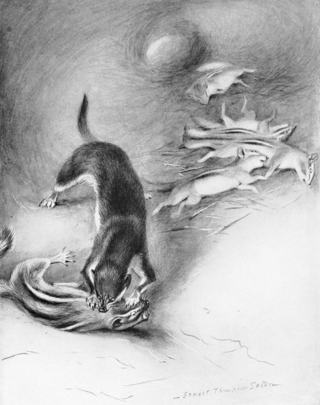Surplus killing
Animal and human predatory behavior From Wikipedia, the free encyclopedia
Surplus killing, also known as excessive killing, henhouse syndrome,[1][2] or overkill,[3] is a common behavior exhibited by predators, in which they kill more prey than they can immediately eat and then they either cache or abandon the remainder. The term was invented by Dutch biologist Hans Kruuk after studying spotted hyenas in Africa[4] and red foxes in England.[5][6]


Species
Some animals which have been observed engaging in surplus killing hunt alone, some are mainly pack hunters. Some opinions include humans.[7]
Bears: brown bears,[8][9] American black bears,[10] polar bears.[11]
Large cats: jaguar,[citation needed] leopards,[12] lions,[11][12] lynxes.[13]
Canines: wolves,[14] coyotes,[11][15] red fox,[5][6] dogs.[citation needed]
Others: martens,[16] weasels,[17] honey badgers,[12] minks,[18] raccoons,[19] spotted hyena,[4] orcas.[20]
Invertebrae: zooplankton,[21] damselfly naiads,[22] predaceous mites,[citation needed] spiders.[12]
Example cases
In Tasmania, in a single dog attack, 58 little penguins were killed.[23] In mainland Australia, a single fox once killed around 74 penguins over several days, eating almost nothing.[24] One leopard in Cape Province, South Africa killed 51 sheep and lambs in a single incident.[25] Similarly, two caracal in Cape Province killed 22 sheep in one night, eating only part of the buttock of one carcass.[26] Up to 19 spotted hyenas once killed 82 Thomson's gazelle and badly injured 27, eating just 16%.[1]
In late autumn, least weasels often surplus-kill vole and then dig them up and eat them on winter days when it is too cold to hunt. In March 2016, a pack of 9 grey wolves in Wyoming was found to have killed 19 elk. John Lund, of the Wyoming Game and Fish Department, said that he had never documented surplus killings that extreme from grey wolves.[27] In Florida, laboratory experiments documented cases of surplus killing in larvae of the predatory midge Corethrella appendiculata against specific larval stages of different species of mosquitoes of the genus Toxorhynchites.[28]
Possible causes
In surplus killing, predators eat only the most-preferred animals and animal parts. Bears engaging in surplus killing of salmon are more likely to eat unspawned fish because of higher muscle quality, and high-energy parts such as brains and eggs.[1] Surplus killing can deplete the overall food supply, waste predator energy and risk their being injured. Nonetheless, researchers say animals surplus-kill whenever they can, in order to procure food for offspring and others, to gain valuable killing experience, and to create the opportunity to eat the carcass later when they are hungry again.[1][29]
See also
References
Bibliography
Wikiwand - on
Seamless Wikipedia browsing. On steroids.
